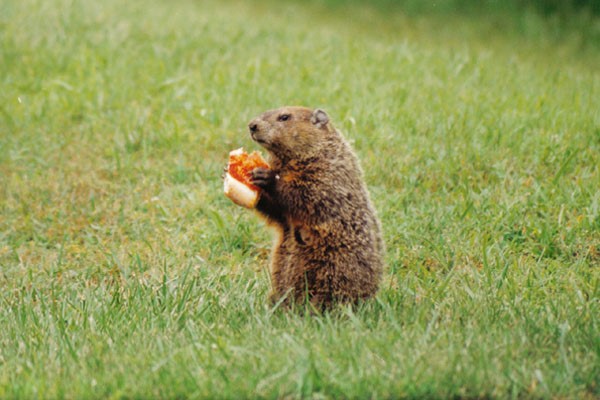
Serving Southwest Ohio and Northern Kentucky

info@TheBugBusters.net.
Attention Realtors and Loan Officers: Click the link for our online inspection sheet.
About Groundhogs
Groundhog
The groundhog, aka “Woodchuck” and “Whistle Pig” is the largest member of the squirrel family typically measuring 17 to 26 inches long (including a 6-inch tail) and weighing 4 to 9 pounds. In areas with few natural predators and large quantities of food, groundhogs can grow to 32 inches and 30 pounds. Groundhogs are well adapted for digging, with short but powerful limbs and curved, thick claws. Unlike other squirrels, the groundhog's spine is curved, more like that of a mole, and the tail is comparably shorter, only about one-fourth the length of its body. Suited to their temperate habitat, groundhogs are covered with two coats of fur: a dense grey undercoat and a longer white topcoat that gives the groundhog its distinctive "frosted" appearance.
Groundhogs usually live from two to three years but can live up to six years in the wild. Common predators include wolves, coyotes, bobcats, bears, large hawks, and owls. Snakes can easily enter the burrow and feed on the young.
Mostly herbivorous (feeding only on plants), groundhogs eat wild grasses, berries, agricultural crops, and other vegetation when available. Groundhogs also eat grubs, grasshoppers, insects, snails and other small animals, but are not as omnivorous (feeding on plants and animals) as many other squirrels.
Groundhogs are excellent burrowers, using burrows for sleeping, rearing young, and hibernating. The average groundhog has been estimated to move approximately 35 cubic feet, or 700 pounds of dirt when digging a burrow. Though they are the most solitary of the squirrels, several individuals may occupy the same burrow. Groundhog burrows usually have two to five entrances, providing groundhogs their primary means of escape from predators. Burrows are particularly large, with up to 45 feet of tunnels buried up to 5 feet underground and can pose a serious threat to agricultural and residential development by damaging machinery and even undermining building foundations.
Groundhogs are one of the few species that practice true hibernation, and often build a separate "winter burrow" for this purpose. This burrow is usually in a wooded or brushy area and is dug below the frost line and remains at a stable temperature well above freezing during the winter months. In most areas, groundhogs hibernate from October to March or April, but in milder regions, they may hibernate as little as 3 months. To survive the winter, they are at their maximum weight shortly before entering hibernation. They emerge from hibernation with some remaining body fat to live on until the warmer spring weather produces abundant plant materials for food.
Despite their heavy-bodied appearance, groundhogs are accomplished swimmers and climbers, and will climb trees to escape predators or survey their surroundings. They prefer to retreat to their burrows when threatened, and if the burrow is invaded, the groundhog tenaciously defends itself with its two large incisors and front claws.
Groundhogs are generally territorial among their own species and may skirmish to establish dominance. Outside their burrow, individuals are alert when not actively feeding. It is common to see one or more nearly motionless individuals standing erect on their hind feet watching for danger. When alarmed, they use a high-pitched whistle to warn the rest of the colony. This is where the nickname “Whistle Pig” originates.
Usually, groundhogs breed in their second year, but a small portion may breed in their first. The mating season extends from early March to mid or late April, after hibernation. A mated pair remains in the same den throughout the 28-32 day gestation period. As birth of the young approaches in April or May, the male leaves the den. One litter is produced annually, usually containing 2-6 blind, hairless and helpless young. Young groundhogs are weaned and ready to seek their own dens at five to six weeks of age.
Groundhogs prefer open country and the edges of woodland, and it is rarely far from a burrow entrance. Since the clearing of forests provided it with much more suitable habitat, the groundhog population is probably higher now than it was before. Groundhogs are often hunted for sport, which tends to control their numbers. However, their ability to reproduce quickly has tended to mitigate the effects of sport hunting. Consequently, the groundhog is a familiar animal to many people in the United States and Canada.

Common characteristics of Groundhogs in our area is that they are the largest member of the squirrel family, can be extremely aggressive. They average in Size from 9 to 30 pounds and 17 to 32 inches including tail. Color: combination of gray, brown and white distinctive "frosted" appearance.
BugBusters has fixed prices to trap and remove Groundhogs:
$350.00 for one week.
$200.00 for any additional weeks.
Prices subject to change without notice.
Dayton, OH 45401-3151
Phone 937-256-6475
info@TheBugBusters.net
Powered by w3.css